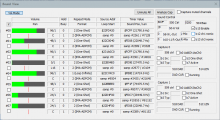Never seen that format before and I do make a habit of pulling apart the odd ones (
http://gbatemp.net/threads/the-various-audio-formats-of-the-ds.305167/ ).
If you just want to trip them then emulators are probably your better bet. If there are no quiet points in the game then you might be able to remove the sfx or vice versa if you want to rip those.
Taking a look at the stuff provided.
They compress fairly well there it seems which is sort of odd as most will toss in at least a basic compression but OK.
I might have to take a look at the whole ROM to make sure there are no helper files to go with those.
Anyway no apparent names in the file.
I did a raw data import in audacity using PCM and ADPCM. Sounded at points like I was in a modern film trailer ("BWAHHH") but comparing to
some of the things I heard matched a bit and while I don't know if it was emulation quality or youtube quality it matches what most devs of such games did with the DS hardware.
Anyway 2.1 megs is not an awful lot for a game's worth of music in raw formats so they might have done a sequenced track (like midi except no indicators that this is midi like some other games we saw) and what I was hearing was the instruments for it. That is rare as most devs did not make their own formats.
Trying the sfx instead got me somewhere. Importing in audacity as raw audio and selecting ADPCM (the DS supports it in hardware after all) at 22050Hz (this might vary a bit so try in audacity as it will tell you the sample rate being used at any given time in its audio window) got me a long list of sound effects like in the video and what I generally hear in games.
The start of the files if you set the width of the hex editor to C per line has what looks like a setup/header section. The sfx one has a lot more entries as one would expect, the music one has far fewer before we see lots of 00s again as one might expect (
https://gamefaqs.gamespot.com/ds/950911-club-penguin-elite-penguin-force/cheats says 13 missions in the game, add on some for the menus, credits and such and that is about right ).
The sfx one has a lot of the same value in the header ( 22 56 02 00 ) which makes me wonder if it is a volume/sample rate type indicator. This should be easy enough to test as fiddling with the number should then change the volumes or playback speed.
The very start of both files is 0101 in hex which is OK. After that in SFX is AF00 which if you divide the length of the section (837 hex) by C you get AF (things on the DS tend to flip due to endianness). It is 4A in music.bin which is smaller as befits the smaller section, though causes some problems as it does not match a lot of what I am seeing right now (if it is is midi that might be a different matter).
The sfx stuff appears to start at 0A00, lo and behold the next part of the header section for SFX is 000A
Carrying on in SFX the next two values when flipped say 1000 and 2400, you will never guess where the following two sections start. The following sections appear to be increasing in number in that position
00 3E 26 00 ( is the last entry and that matches what I am seeing as the last sound effect in the file.
If the start identical sections are volume or something we then have a third "column" to look at. It is somewhat random compared to the others.
Size of section is usually a good start here but where I am seeing a big number in said column I am not seeing a correspondingly large jump in location. Could still be (might be that the upper bits are used for something else) but who knows.
Back to music.
This seems less obvious.
The numbers seem to be increasing for the most part*. The last entry (6C 31 20 00) when flipped gives 0020316C which does appear to be right before the end of the file and what could be the start of something.
*there appear to be 3 entries at the start but the third one is odd. Bonus here is 1B which is earlier in the header is 27 in decimal and there are 27 entries after that odd one.
This one might take a little longer and it appears to be 4am here so I will leave that one for now.
Header section from the music.bin file split into columns
Code:
01 01 4A 1B
----
54 E1 1D 00
D0 E1 1D 00
24 67 01 00
F4 48 1F 00
48 51 1F 00
9C 59 1F 00
F0 61 1F 00
58 6B 1F 00
C0 77 1F 00
04 7D 1F 00
68 87 1F 00
80 8E 1F 00
D8 97 1F 00
F0 9E 1F 00
58 A8 1F 00
B8 B1 1F 00
8C B8 1F 00
A4 BF 1F 00
F8 C7 1F 00
6C D6 1F 00
D4 E1 1F 00
48 F0 1F 00
80 F3 1F 00
D0 FB 1F 00
AC 03 20 00
08 0E 20 00
48 12 20 00
9C 19 20 00
0C 27 20 00
6C 31 20 00







